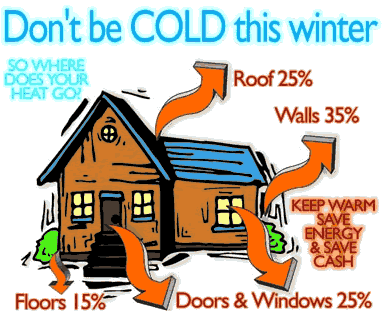Home Energy

We wrap up in cold weather, so why not do the same to your house. The following will help you keep your house warmer, manage your energy use and reduce CO2 emissions (the greenhouse gas which is partly responsible for causing adverse climate change).
- walls, floors and roofs
- cavity walls – inject insulation into the cavity between the outside and inside walls of your property
- solid walls – insulation can be fixed to the outside or inside of properties by specialist companies
- party walls – insulation can be installed in vented cavity walls between neighbouring properties to prevent heat escaping into the loft space.
- room in roof/ loft conversions – a layer of insulation covering every external surface can be installed to minimise heat loss.
- loft insulation – the recommended depth of loft insulation is 270mm
- flat roof insulation – a layer of insulation can be built into the structure at some level by a professional roofer or specialist insulation company
- suspended timber floor - netting laid over and between the exposed joists holds the insulation in place underneath the floor
- solid floor – a layer of rigid insulation board can be laid on top of the existing concrete, or the existing concrete can be dug out, a new layer of damp-proof and rigid insulation installed before a new concrete screed or other flooring is laid.
- double/ triple glazing – fitting higher performance windows will reduce heat loss
- secondary glazing – this is a cheaper option than replacing windows and won’t change the appearance of the window outside
- outside doors – well fitted and highly insulated doors will help keep your home warm
- Draughtproofing – installing draughtproofing around windows and doors will cut down on cold draughts
- Heating and hot water
- New condensing gas boiler – replacing your gas boiler with a more efficient model can cut your heating bills significantly
- Hot water cylinder thermostat – fitting a hot water cylinder thermostat will help keep your hot water at the right temperature and avoid wasting energy keeping the water hotter than needed
- Hot water cylinder insulation – insulation keeps the heat in the cylinder and ensures the water stays hot
- Heating controls – will help keep your home comfortably warm
- Programmer – enables the time to be set for the heating to come on automatically
- Room thermostat – enables the temperature to be set for that room, and when it is reached the heating will turn off
- Thermostatic radiator valves – they control the temperature in rooms that do not have a room thermostat.
- low energy lighting
- fit new energy efficient bulbs whenever you change a lightbulb
- LEDs (Light Emitting Diodes) are suitable for most standard light fittings (however be aware there may be compatibility issues with dimmer/ low voltage fittings – i.e. those with a transformer). If you unsure seek expert advice.
Contact Us
Tel: 01304 872414
Email: energy@dover.gov.uk